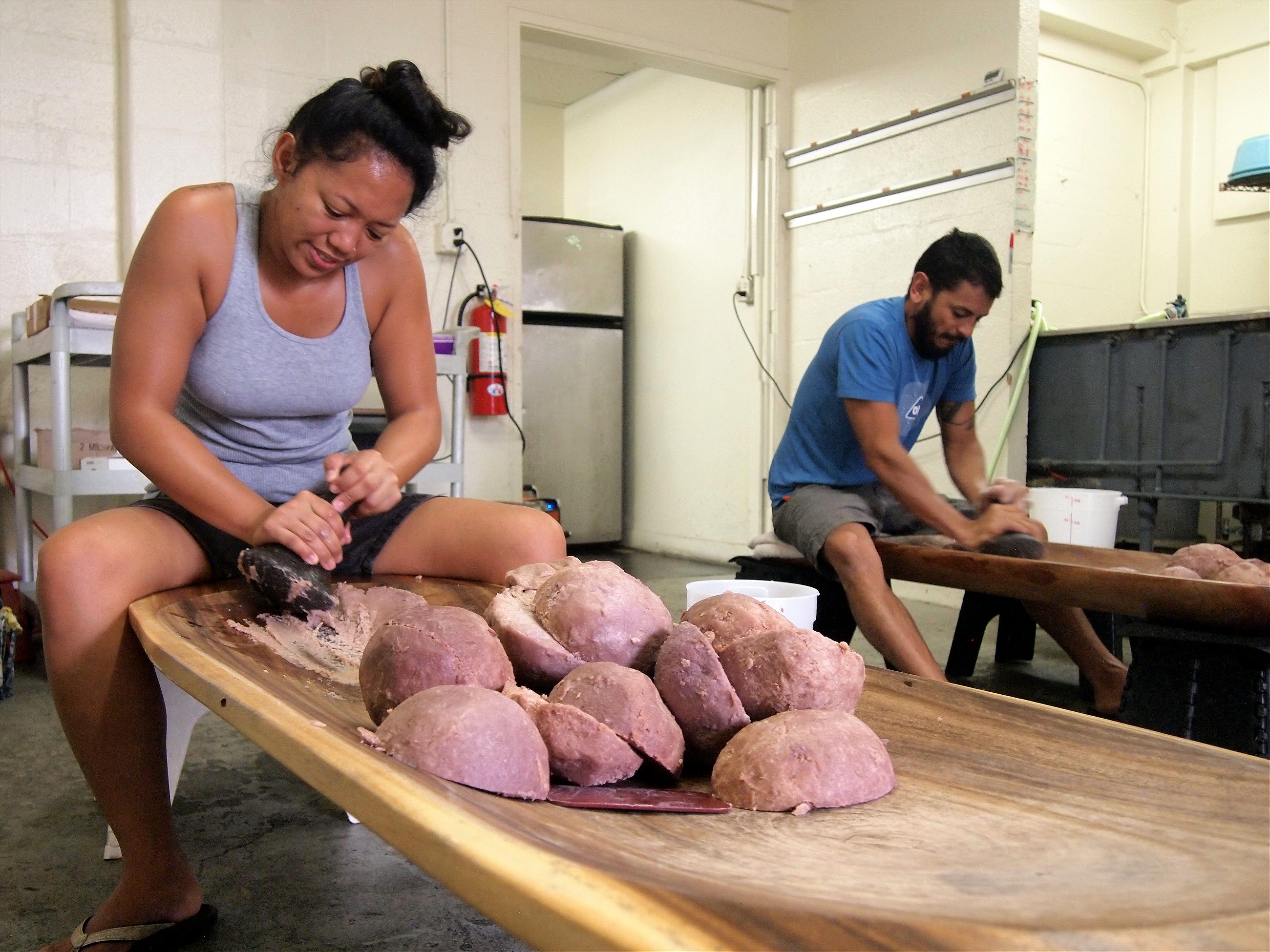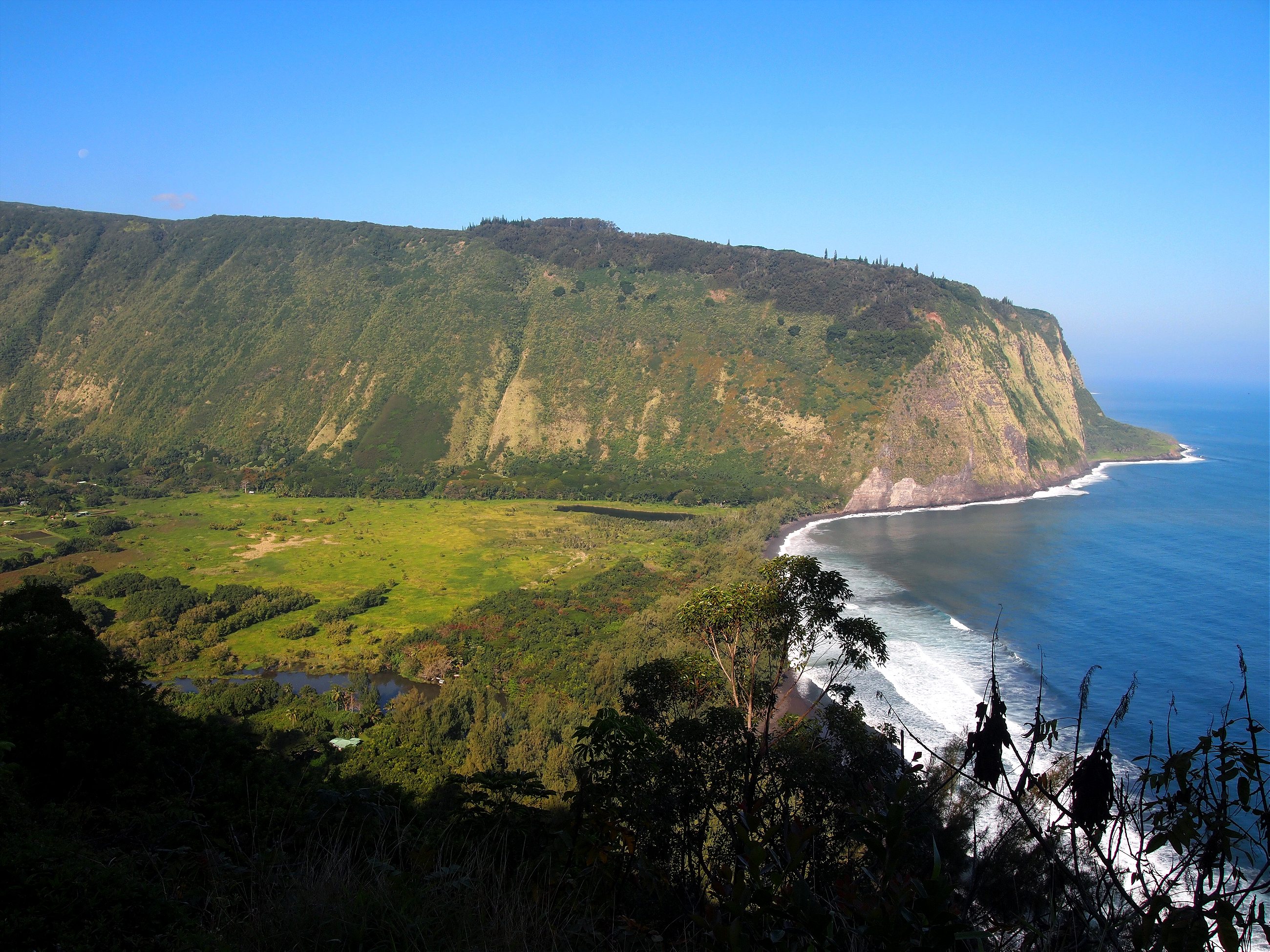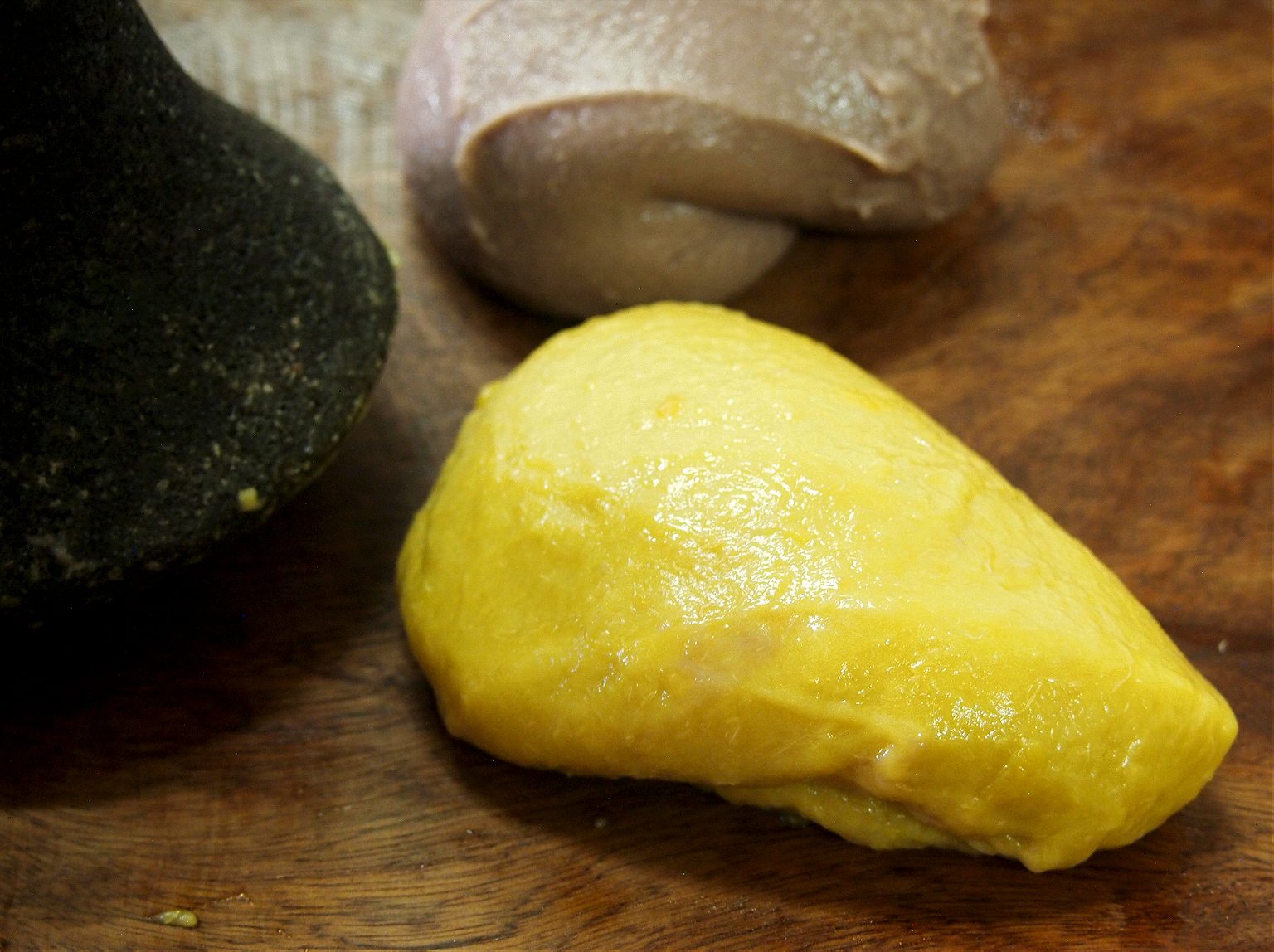A pounded dough that sustained ancient Hawaiians on their journeys across the Pacific is making a comeback as part of a locavore movement.
When I arrive at Mana Ai’s small industrial kitchen, a 21-year-old employee named Ka’le “Uhi” Maunakea is straddling a six-foot-long wooden board, one end piled with cooked taro the size of lavender ostrich eggs, the other smeared with what looks like ragged Play Doh. Lifting a heavy basalt pestle above his head, he heaves it into the mash, kneading and pounding until the taro—a starchy root vegetable—forms elastic dough that jiggles with each collision of the lava rock.
Customers lounge in the doorway, watching, while another worker, Fehren Jones, cuts the pounded dough called pa’i’ai into purple-red slabs that glisten like steak on the wax parchment. Then she wraps them in long narrow tileaves tied tight with string. Minus the parchment paper, these green, leaf-bound packages are what sustained the ancient Hawaiians on their voyage across the Pacific Ocean a thousand years ago.
Pa’i’ai was the original instant travel meal: just add water and it expands to form poi, a wet, creamy starch that was the staple of the Hawaiian diet. Leave the poi in the heat for a few days, and it ferments into sour poi, a gluten-free probiotic with significantly more bacteria per gram than yogurt. In Hawaii it’s called a “local superfood” and today it is center to the meeting of worlds for Whole Foods yuppies, gourmands, indigenous cultural activists, locavores, environmentalists, and doomsdayers worried about the fact that Hawaii imports 85 percent of its food from 2,400 miles over the ocean.

Fehren slaps a piece of pa’i’ai in my open palm to taste and I play with it, pulling it apart and watching it recoil, before taking a nibble. It’s chewy and moist, with the faint sweetness of a mochi-ball. For comparison she gives me a slice of un-pounded taro, and the difference in texture is remarkable. Without the impact of the heavy stone, the taro is crumbly and dense, almost like pastry dough.
Daniel Anthony, Mana Ai’s founder, arrives shortly before lunch. He takes a phone call, and then settles onto the second board to pound poi. “I hope you’re not disappointed that we aren’t wearing our traditional loincloths,” he jokes. A few minutes later, he gets up and films a 15-second Instagram videoof Maunakea and Jones pounding. Pounding poi is an ancient practice, but this is Honolulu in 2016 and contemporary, artisanal poi is in its infancy.
Selling and distributing hand-pounded poi has only been legal since 2011. The prohibition lasted exactly 100 years, beginning in 1911 when the Hawaiian State Department of Health traced an outbreak of cholera to poi diluted with unclean water. It finally ended when community organizers, including Hawaiian cultural educators, small taro farmers, and advocates of sustainable food sovereignty, like Anthony, convinced the Hawaiian legislature to grant poi-pounders the same cultural exemptions from health regulations that raw honey, steak, and sushi had enjoyed for years.
In the years between 1911 and 2011, only mechanized poi-mills were permitted to stay in operation, making what Anthony considers a bastardized version of poi.
“The ancient Hawaiians wouldn’t even recognize most of what’s being sold in stores today,” Anthony says. “It’s not the traditional recipe.”
According to Anthony, it’s the attention to detail by a human hand that differentiates high-quality from low-quality poi. Pulling a still-hot taro from the pressure cooker, Fehren points to the way some parts of the taro have caramelized under heat, turning a deep, rich color. This part is called koena, and Jones scrapes it into a container to sell to restaurants for desserts. Still warm, it’s gooey and mildly sweet, like toasted rice.

She places only the pastel-colored, crumbly, starchy pieces of taro on the pounding board. A lot of poi quality is about controlling bacterial cultures and rates of fermentation. Removing the koena, a process omitted at poi mills, lowers the sugar-to-starch ratio and keeps the fermentation process from happening too quickly, preserving the poi and keeping it sweet for longer. This is why Anthony is also careful to buy young taro: The sugar content is lower in immature taro than in the enormous, human-head-sized taros that usually head to the mills.
For high-quality taro, Anthony is willing to pay up to $2 per pound, more than double the $0.80 usually offered taro growers. Mana Ai is helping small taro farmers survive, and hopefully, encouraging them to plant more taro. It’s one reason Micah Olival, a taro farmer in the Waipi’o Valley, told me to visit Anthony.
Pre-contact, the Big Island’s Waipi’o Valley may have supported 1,920 acres of taro, but today there aren’t even 500 acres growing in all of the islands put together. About a third grows in Waipi’o, thanks in part to an endowment by the Bishop Museum that leases land there to around 40 taro farmers. It’s a historical preserve acknowledging that growing taro was and is the heart of Hawaiian society, a symbol of their relationships with each other, their food, and the land. The word for land—‘aina—translates as “full of food.”
Pointing up the valley, Olival spreads his fingers wide to indicate how flush with taro this area once was. We’re standing shin-deep in the flooded fields called lo’i. Beneath my bare feet, the taro roots fan out like knobby ropes of fishing net under a thin padding of wet silt. The edible part isn’t the roots, but the fleshy, swollen stem called a corm, invisible under the brown water.

Around us, the heart-shaped taro leaves bob in a gentle breeze sweeping up the steep chasm from the ocean. Olival steps between the stalks of the clustered plants, softening the interconnecting roots with the crunch of his bare heel. Taros make suckers rather than seeds, meaning that a “mother” plant—the makua—will spawn a cluster of “baby” suckers—the ‘ohā. Together, they’re referred to as ohana—a family of individuals that come from the same source, just like a human family.
In 10 to 12 months, each replanted ‘ohā will yield a new taro corm to ship to Anthony and to feed Olival’s young family.
“We like it every which way,” Olival says. His wife, Nicole, has been clever in using pa’i’ai as a gluten-free base with equally clever names. His kids get real Hawaiian “poizza,” and recently she tried a new breakfast invention; “poiffles.”
Olival rubs a velvety leaf between his fingers. This is the one his family really likes. He knows the 10 varieties of taro in his fields by the shape and color of their leaves. There’s ele ele makoko with the black stem, and api’i, with its curly leaves. Gripping a pink-streaked, Y-shaped stalk just below the leaves, he rips the corm out of the mud and rinses it in the brown water. When he slices through its hairy corm just below its pink crown, he reveals the taro’s white heart.
This is the other reason the poi in stores today might have been unfamiliar to ancient Hawaiians: While purple poi is nearly ubiquitous today, their poi was more likely to be other colors.
Pre-contact Hawaiians grew upwards of several hundred varieties of taro, each with a specific culinary purposes. In addition to poi taros, there were “table taros” to eat in potato-like cubes; sweet dessert taros to blend with coconut and sugar cane; and taros with tender leaves for boiling in coconut milk into a stew called lū‘au, the dish that gave the classic Hawaiian feast its name. Taros were white, pink, yellow, orange, or even greenish, like lena-lena. A few were purple. These were used as offerings to the gods, or under kapu law, consumed by the chiefs.

On the day I visit him, Anthony has two taro varieties on the pounding board: a purple lehua, and a canary gold mana ulu. Anthony says he would buy a greater diversity of taro varieties if farmers grew them, but right now getting a large enough quantity of any taro is a problem, never mind the variety.
“Which do you think the restaurants prefer? Purple poi, or yellow poi?” Anthony asks. “Of course they’re going to want the yellow, because it’s different.”
Fehren takes a mana ulu corn from the pressure cooker and shows me how she scrapes away the hairy skin with her thumbs. Inside, the taro looks like egg-yolk, mottled with the translucent, caramel-colored koena. Mana ulu takes longer to cook and I’d been waiting all morning to see its color.
“Taste it. You can tell the difference,” Jones says. She hands me a wedge of unpounded mana ulu. She’s right; it’s richer, denser, and almost buttery compared to the slightly sweet purple variety I tasted earlier in the day.
Jones says the pa’i’ai is different too, more like tofu in texture. “You’ll see,” she says, and pounds the taro until it’s shiny, canary-yellow dough. When she rips off a piece, the texture is more like thick bread dough than rice mochi. It’s even stickier than the purple, with more to chew and a bready flavor. Anthony snaps an Instagram pic. This is poi for a new generation.